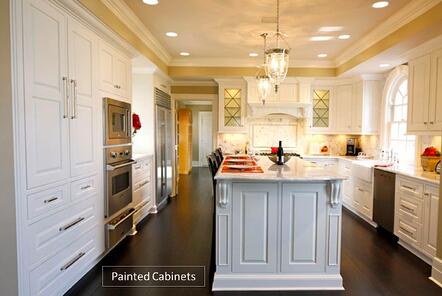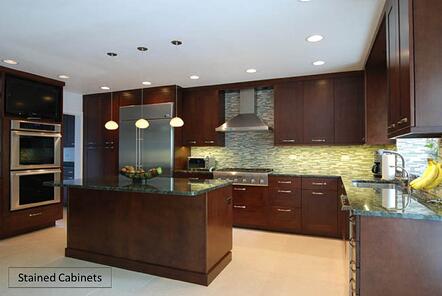 One of the most frequent questions we are asked in regards to custom kitchen cabinets is: Is it better to paint or stain cabinets?
One of the most frequent questions we are asked in regards to custom kitchen cabinets is: Is it better to paint or stain cabinets?
With the the availability of modern finishes for custom kitchen cabinets, it really comes down to your personal aesthetic preferences. Many homeowners simply prefer the look of natural wood grain, including any visible knots or "imperfections". In fact, many clients feel it's a travesty to paint over the beauty of natural wood. Others like the more uniform and streamlined look available from the infinite variety of paint colors.
Here is a brief breakdown of the differences between painting or staining custom kitchen cabinets.
 Aesthetics. Here, it's a matter of personal preference. When couples are at a stalemate about painting or staining, we say, "why not do both?" Two-tone kitchens are popular. You can achieve this look by painting your cabinets and leaving the kitchen island and/or other accents - such as the pantry, cookbook shelves, etc. stained. In addition to a compromise, this can add visual interest to your overall design.
Aesthetics. Here, it's a matter of personal preference. When couples are at a stalemate about painting or staining, we say, "why not do both?" Two-tone kitchens are popular. You can achieve this look by painting your cabinets and leaving the kitchen island and/or other accents - such as the pantry, cookbook shelves, etc. stained. In addition to a compromise, this can add visual interest to your overall design.
Often we are asked "how can you tell the difference between a stain and a paint?" The answer is simple: if you cannot see any grain chances are it has been painted.
Durability. It really comes down to the finish products that are used. We always recommend painted and stained cabinets be finished with a high-quality protective coating. In addition to protecting your cabinets from daily wear and tear, moisture, and the inevitable bumps and scuffs, it will also make it that much easier to clean them. With the right finish, a soft, damp, lint free cloth is all you'll need to keep them looking fresh. You will need to occasionally oil wood cabinets without a protective finish.
Keep in mind that this same finish will make it more difficult to repaint your cabinets down the road. While the internet is full of information about "easy" DIY cabinet repainting, we don't recommend it. It takes a tremendous amount of time, patience, and energy to do the detailed of sanding, priming, and painting necessary for a professional finish. You're much better off hiring a professional and you may want to get a quote for a custom kitchen cabinet replacement as the price might be surprisingly comparable to a re-painting job!
Humidity. Here is something that isn't discussed enough when it comes to cabinet care and maintenance. Humidity is your cabinets' nemesis. When humidity levels are too low - below about 40% - wood becomes dry, causing it to constrict and split. If humidity levels are too high - above 60% - wood can swell, warp, and split. Use your hood vent whenever you are cooking and speak with an HVAC technician about options for maintaining consistent whole-house humidity.
Contact Kitchens & Baths Unlimited to learn more about whether staining or painting makes more sense for your custom kitchen cabinets.



